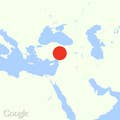HATAY PROVINCE, Turkey — A fine white dust covered Mohamed’s bare feet as he stepped onto the ancient mosaic. It had been rolled up in an old carpet, its hundreds of stone pieces glued in place on an elastic sheet. Unfurling the carpet released the smell of earth into the humid air.
Dust coated the mosaic too, obscuring a scene rendered by an unknown artist from antiquity. “Put some water here,” Mohamed said, clicking the trigger on a spray bottle. “It will become clear.”
A man’s face appeared on the stones. He wore a crown and sat upon a throne. Mohamed sprayed water to the right and there was a soldier, leading a prisoner with bound hands. The king held his palm above the prisoner, passing judgment. “First look at the eyes,” Mohamed said, his bottle still clicking. “You will think they are real and they have souls.”
Looters found the mosaic in Syria, in the floor of an ancient villa buried underground. First they covered it with elastic glue and, using a rubber hammer, tapped the pieces into place. When the glue set they peeled the mosaic from the floor. Then they rolled it into the carpet and smuggled it across the border into Turkey, where Mohamed, a black-market antiquities dealer in his mid-thirties, hid it in his home.
Tall and athletic with intense brown eyes, Mohamed crouched down to scoop up some stones that had come loose from the mosaic, dropping them into a plastic bag. When he began trading stolen antiquities, in 2003, he was hoping to make a better living under a dictatorship with few options for ambitious men with no ties to the ruling elite. Now he is a veteran of a trade that has exploded with the chaos of a brutal civil war, using the money to support his extended family living in Turkey as refugees. The work relies on secrecy — to avoid arrest and to hide the illicit origins of the artifacts, so they can adorn homes and galleries worldwide — so Mohamed asked to use only his first name.
Four years into a conflict that has killed more than 200,000 and displaced millions, Syria’s immense history is being sold off on en masse as looters descend on ruins across the country. An untold number of people have joined Mohamed in a black market that helps to fund armed groups from ISIS to Western-backed rebels to the Syrian regime. Many of the newcomers have no interest other than making money, but Mohamed is enamored with the history of the ancient objects in which he trades. Known among his colleagues for having an expert eye, his phone buzzes endlessly as he receives photos via WhatsApp from sellers trying to catch his interest and fellow traders wanting advice. People ask him to come and “talk” with their artifacts. “Falso,” he says, his voice rising, when he sees a forgery. If he likes a piece, he calls it “fantastic.”
“We have been living in a war for more than four years, and people will do anything to feed their kids.”
The mosaic was looted from Apamea, a city in northwest Syria with vast ruins that are under rebel control. Mohamed bought it for $21,000 from a dealer in Syria and hoped to sell it for $30,000. He guessed the mosaic might change hands once or twice more from there — and that its final destination, like its original one in ancient times, would be a rich person’s villa. Wherever it ends up, the mosaic, still stuck to its elastic sheet, will be set again inside a wall or on a floor. Then the elastic will be peeled back, revealing the front of the mosaic once more, the colors much deeper than on the flip side that Mohamed showed me in the bedroom near the border. By this point, he will be a forgotten part of the mosaic’s long history. “I’m invisible,” he said.
Over the course of a month, I traveled along Turkey’s 565-mile-long border with Syria to meet more than a dozen people involved in this illegal trade, from the grave robbers and excavators who steal the artifacts to the middlemen and dealers who sell them. They showed me photos and videos of items for sale and let me view in person three high-value objects, including the mosaic, that are normally kept hidden from anyone who isn’t part of this underground world. For the same reasons as Mohamed, all requested anonymity.
Convinced that their artifacts were destined for Western buyers, these sources opened a window onto the extent of the looting and the guile and professionalism with which their trade is carried out.
They also spoke to the desperation that fuels the pillage. “We have been living in a war for more than four years, and people will do anything to feed their kids,” said one middleman on the border, guilt-ridden over his role in bleeding Syria’s history. “I don’t care if the artifact is coming from [rebels] or from ISIS. I just want to sell it.”
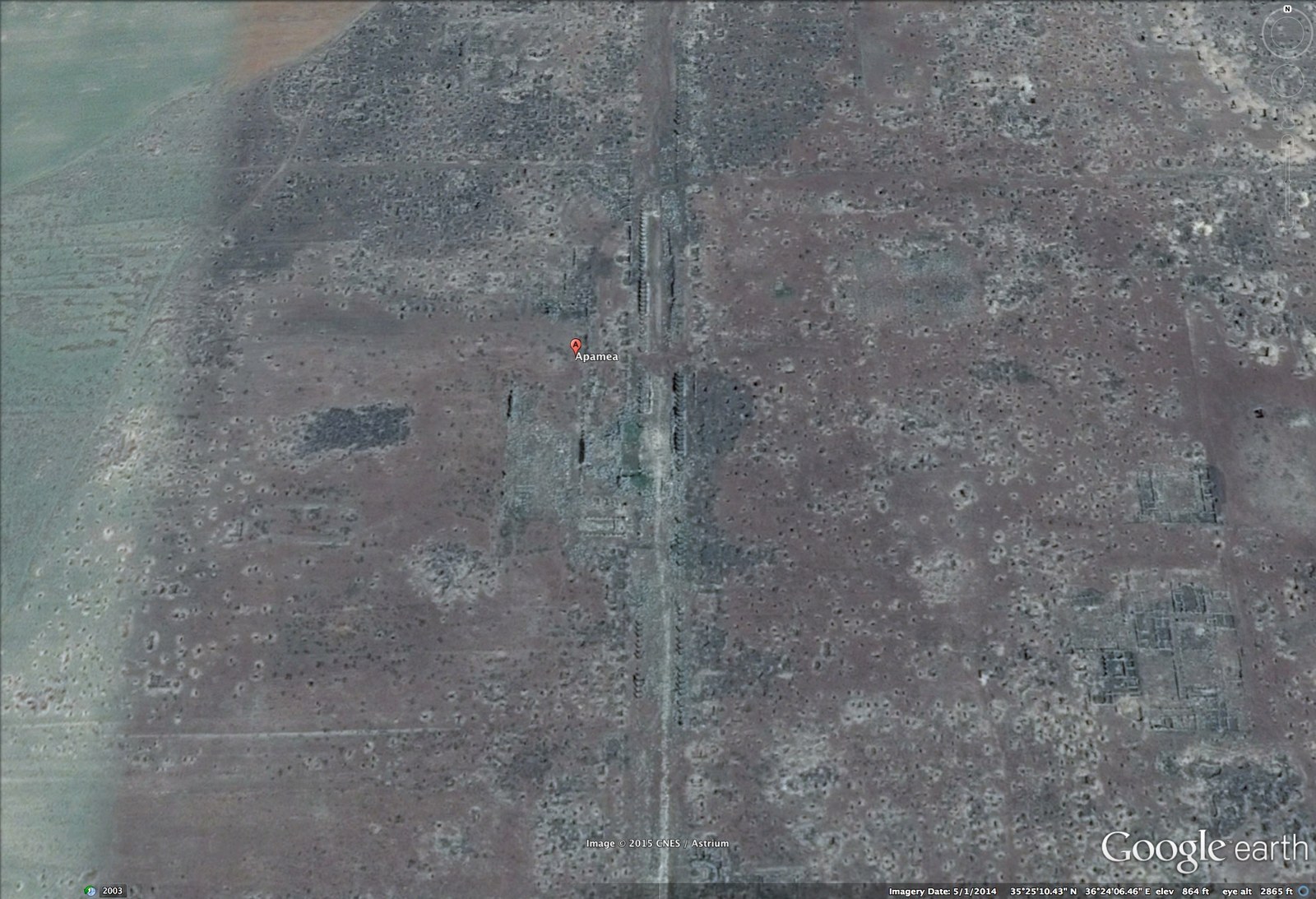
In order for traders to sell antiquities, diggers around Syria work daily to pull them from the ground. The digs range from backyard affairs by heavy-handed amateurs to skilled excavations.
One such digger, a 36-year-old Syrian, works near Apamea with permission from a local rebel group, rolling a bulldozer over acres of land to turn up small artifacts or uncover clues that might lead to a greater score, such as an ancient burial cave. Inching through the chambers and reaching into tombs can be exhilarating as he wonders what he’ll find. He might discover jewels that wealthy citizens of past empires took to the grave. Often, he said, “there are only bones.”
On a warm evening in June, he and a colleague sat on the floor of a living room near the border and served tea as they waited out the last hour of the Ramadan fast. The two men are part of a team of six that splits any money they make. They can go for weeks without a payday, sweating “for nothing” in the sun, the digger said.
“We feel bad because we are stealing our history and selling it for a cheap price,” his colleague said. “But we have become homeless and jobless, so we don’t care.”
Another digger, who goes by the nickname Abu Mohamed, seemed motivated less by the potential profit than by the sense of possibility the work gave him in such hopeless times. “I dig because I like it, and if you start digging, then you will like it also,” he said. “You can’t stop.”
He said he and his fellow diggers had a name for themselves: “Brothers of the sand.”
These videos show a group of men digging for artifacts in the province of Deir Ezzor, currently an ISIS stronghold.
Syria was home to some of the world’s most ancient civilizations, dating back to at least 7,000 B.C., and has been part of some of history’s most famous empires: Egyptian, Babylonian, Persian, Greek, Roman, Umayyad, Ottoman. With each object torn from its home, another link to the past is broken. To help put the destruction into perspective, I traveled to London to speak with archaeologists who specialize in the region. St John Simpson, 53, met me in his cluttered office in the British Museum, where he is the senior curator responsible for the pre-Islamic collections from Iran and Arabia. “There are thousands of sites across Syria, and the destruction of any of them is an irrevocable loss for humanity,” he said. “It’s a loss for Syria and a loss for the world.”
The risks of traveling to Syria make the looting all but impossible to witness firsthand, leaving archaeologists with little more than satellite images that reveal a pockmarked landscape. But one activist on the border sent me videos that he said came from a dig outside the eastern city of Deir Ezzor last year. The province is an ISIS stronghold today, but the exact location of the dig was unclear, as was who controlled that patch of turf at the time. Videos like this have never been published before: They show workers in well-dug excavation pits near the Euphrates River, chiseling around artifacts and brushing them clean. The camera pauses on old documents from a 2009 excavation that suggest the workers are in Dura-Europos, an important archaeological site that ISIS has looted extensively.
When I showed the videos to Mark Altaweel, an archaeologist at University College London who has worked extensively in Syria, he was shocked by the professionalism. “This is like a proper excavation here. It’s what we do!” he said. “These are people who have done this before.”
More than any group, ISIS has managed to undertake the search for antiquities on a massive scale. It has also looted artifacts from Iraq — the U.S. government said earlier this month that it recovered a stash of Iraqi artifacts during a commando raid that killed an ISIS leader in Deir Ezzor in May. It is one of several income sources of note for ISIS, whose revenue streams range from local extortion and oil sales to ransom from kidnappings.
A former museum worker from Deir Ezzor, a 45-year-old Syrian who goes by the nickname Abu Karim, said he was struck by the extent of ISIS’s antiquities operations when he saw them up close.
I met Abu Karim at a café in the Turkish city of Sanliurfa, near the border with ISIS territory. He said his prewar job was restoring antiquities, taking him to museums and archaeological sites around the country. When the fighting started, he made rebel groups maps of places to search for ruins and helped them dig. He cringed at the looting, he said, but hoped the money would pay for things like weapons and schools. When ISIS overran much of Deir Ezzor last summer it was quick to offer him an ultimatum, he said: Work with us or die.
The first thing Abu Karim noticed were the machines the extremists owned: metal detectors and treasure hunters that scan the ground for buried objects, like the Golden King Plus, shown above, which retails online for $5,900. There were also bulldozers, hydraulic diggers, and boxes of dynamite. They don’t need an expert like me, Abu Karim recalled thinking.
ISIS allowed civilians with the know-how to dig on their own, granting them special permission and charging a 20% tax, Abu Karim said. He also said that ISIS employed special teams to target high-value sites. Experts and sources on the black market supported both of these ideas.


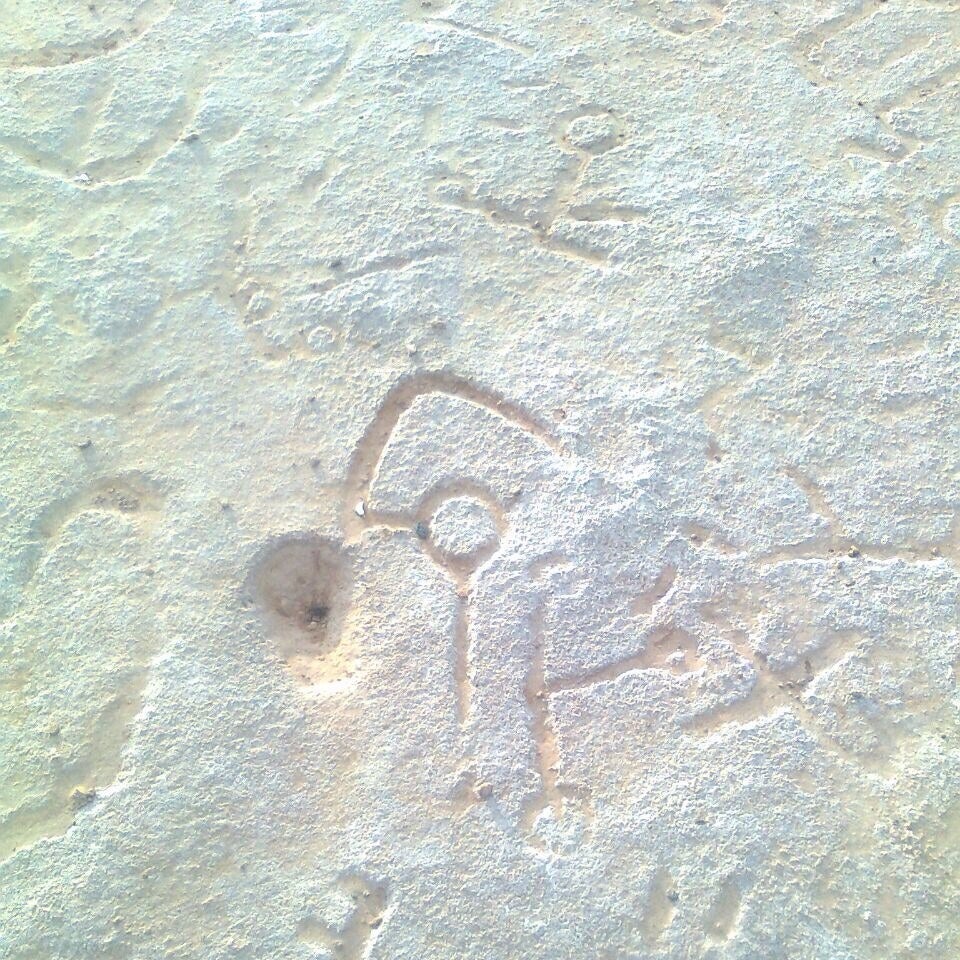
Ancient engravings that, according to local myth, point the way to burial sites housing precious artifacts.
Abu Karim said ISIS also asked him to decipher engravings in rocks that it believed were clues to ancient burial sites, a common local myth. He gave me photos of three that he said he’d been asked to decode. “I told them I’m not a magician,” Abu Karim said, but he went to work.
Six weeks later, fearing for his life, he escaped, reaching Turkey last fall. He said he was sure ISIS had done fine without him. “They have found a lot of artifacts,” he said.
Once artifacts are uncovered, photos of them pass constantly between smartphones, from the looters who uncover the objects in Syria to the merchants and middlemen who market them across its borders and beyond.
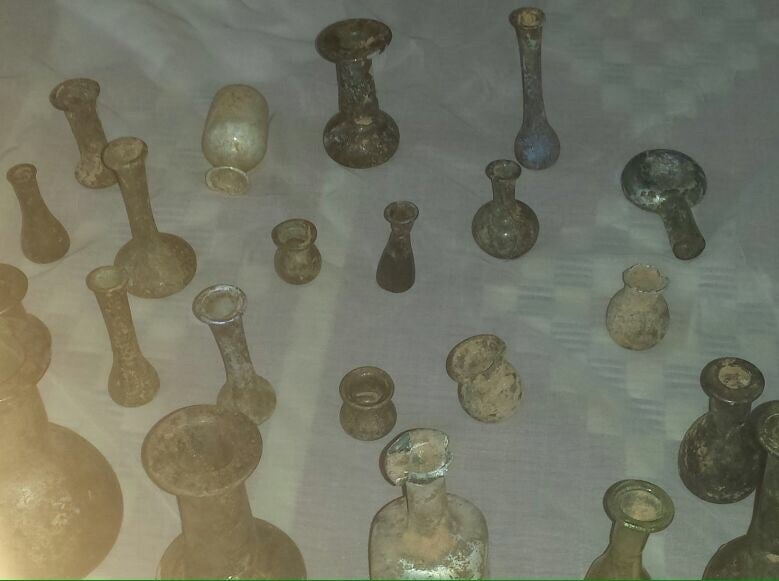
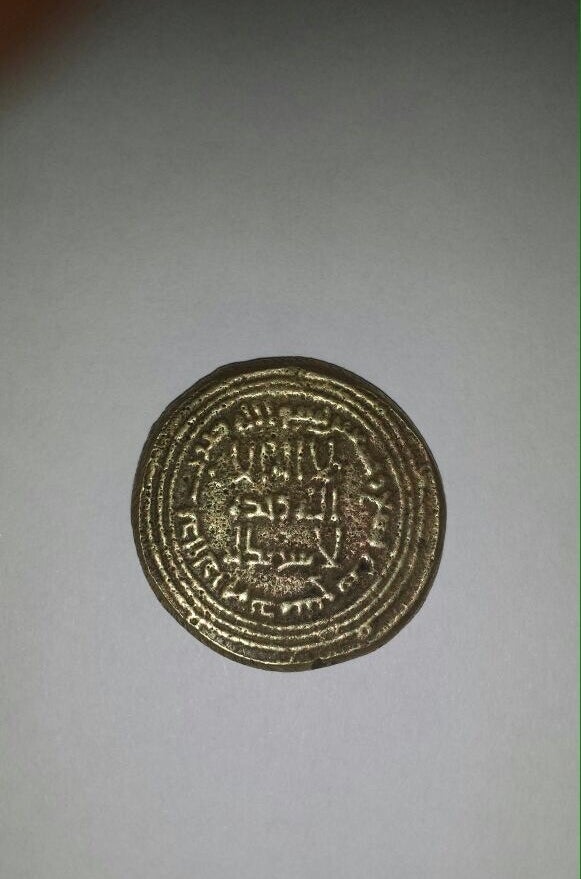
Amateur photos of stolen artifacts — like these, taken from a cache of images held by a middleman — are sent from phone to phone in this underground trade.
In the Turkish city of Antakya, near the Syrian border, a 38-year-old former lawyer and his business partner, a 32-year-old former car salesman, were the kind of middlemen who didn’t have the funds to buy valuable antiquities themselves. Instead, they used the photos to line up buyers, aiming to take a commission. “This work became hope for people, because if you know someone with an artifact, and you help him sell it, then you can both earn some money,” the former car salesman said, sitting in the small courtyard of his apartment building as canaries chirped from two cages overhead.
His partner, the ex-lawyer, was trying to earn enough to smuggle his family to Europe. “I don’t want to keep watching my kids grow here and not be able to do anything for them,” he said. “When I have enough money, I will stop this business. I will quit, I will break my phone, and all my contacts, and all my photos.”
The pair told me they had met Western buyers before, though I couldn’t confirm it. When a deal was in the works, they said, each side had the antiquity in question appraised by its own expert, and then they negotiated over the price. The two men acknowledged that they didn’t have much leverage. “In the end they know the Syrians will accept a low price, because we just want to sell it,” the former lawyer said.
The lure of a potential payday got the better of them as the afternoon in the courtyard wore on. They took out a Ziploc bag full of old coins they said came from Syria, letting me dig through it. Then they asked if I was a buyer in disguise. I assured them I was a journalist, but the former car salesman felt compelled to take another stab: “Are you sure you don’t want to buy something?”

Mohamed, the dealer, was excited — there was a new item on the market that he badly wanted to see. It had fallen into the hands of a Turkish dealer higher up the food chain who often dealt in Syrian antiquities more expensive than Mohamed could afford. Mohamed was paying him a visit and invited me to join.
We left Antakya early in the morning in a beat-up van, driving northeast through the mountains along the border until we reached the city of Gaziantep. The Turkish dealer — a gruff and stocky man in a pink polo shirt and jeans — then joined us in the van. He directed us to the outskirts of the city and beyond as his partner tailed us in a white sedan.
The man didn’t seem to believe I was a journalist, but he was happy to have an American along for the ride. His best client, in fact, was an American, he said. He described the client as a man of about 50 who visited a few times a year with a translator. The last trip had been a few months before. “He is a really good guy," the man said, "and he pays a lot of money."
He took on the tone of a salesman at Istanbul’s Grand Bazaar, claiming he’d never sell a fake to an American because it was against Islam. He said that the item we were headed to see was beautiful, and repeated one of the few English words he knew several times, “Guarantee.”
He added, in Turkish, “I swear on Obama’s life.”
We rolled for miles down a road with nothing but brown grass on either side, arriving finally at an isolated villa. The man and his partner led us inside. Mohamed sat on the floor of an airy den with windows that looked onto a mountainside. Then the man's partner brought in a small bundle covered in a white sheet. Mohamed unwrapped it eagerly. “Slowly, slowly,” the partner said.
Inside was a copper statue about 18 inches in height. It showed what appeared to be a deity from ancient Greece, with laurels in his hair and winged sandals on his feet. Mohamed traced his finger over veins that ran down either arm. It was the kind of classical artifact that can be found in Syria and across the region, a remnant of a time long before today’s borders were drawn. In this case, the Turkish man claimed it had been dug up illegally in Turkey, near the Aegean Sea. This blurring of boundaries can help traders say their objects came from any number of ancient sites outside Syria. Whatever the statue’s origins, it was another item sucked up into a black market that grows with the unrest across the Middle East. One reason Syrian items sell so easily is that this global exchange predated the war; dealers with international connections have often simply folded the new Syrian artifacts into their businesses. The Turkish man said the price for the statue was $250,000, a bargaining position he'd likely bring down significantly.
Mohamed held the statue in his hands as if it were an infant, and then he brought it to his face, pressing his nose against its stomach and inhaling deeply. He was trying to sense the integrity of the patina — the green coating that comes from age — smelling for traces of paint that would tell him it was fake. Satisfied and glowing with a quiet intensity, he pulled a magnifying glass from his pocket and moved it over the statue inch by inch, his right eye pressed against the lens. The room was silent.
Later, on the ride home, Mohamed said he thought the statue was authentic — and a "fantastic" find. He had in mind a buyer who lived in Turkey, he said, and if the price came down he could likely arrange a sale. I asked what would happen to the statue if it ended up in his buyer’s hands. “Direct to Europe,” he said.
“It’s impossible to stop this business: in Europe, in the United States, in all the world.”
The first stop for illicit Syrian antiquities is usually Lebanon or Turkey. Christopher Marinello, the director of Art Recovery Group, which retrieves stolen art on behalf of dealers, collectors, and museums, suggested that this is where the path often ends. Rising scrutiny in the West over artifacts coming from Syria has discouraged even the sale of legal items, he said. “I think the market is shrinking, because this stuff is radioactive,” he said. “The better dealers stay away from it.”
Marinello said it was the idea of selling items to Western buyers — and not Western buyers themselves — that was likely fueling the demand. “I think it’s the middlemen who think that they’re going to find a Western market, and then find a lot of Western markets closed,” he said, adding that there was little hard evidence to support the idea of illicit Syrian antiquities being purchased on a significant scale in the West.
Other experts said the difficulty in establishing the provenance of looted Syrian antiquities, whose illicit origins are being obscured by unscrupulous middlemen, is likely allowing many to be traded in the West. “There’s almost no way to verify these things,” said Altaweel, the University College London archaeologist. “How can you know when and where these things were acquired? It’s just what the dealer tells you.”
Expensive items can also be sold directly to collectors. “It’s all about who is connected to whom,” Altaweel said. "It’s a very personalized trade."
To be traded legally, an item typically needs an export license from the government of the country where it was found or documents tracing its history to a private collection. But archaeologists and other critics of the legal antiquities trade — some of whom believe that that artifacts shouldn’t be bought and sold at all — say it has long been plagued by doctored paperwork. And it can become harder to trace back an object’s path the more it changes hands.
"You literally don't know what's being taken."
To get a sense of some of the material on the market, I sent a cache of more than 50 photos, given to me by one middleman, to several experts. They said many appeared to be fake, reflecting a view held by Mohamed and other sources on the black market that there are at least as many fakes as genuine artifacts for sale. Mohamed asked me not to photograph the mosaic and the statue he showed me, fearing that if an image were published it would scare away buyers. While only an expert would be able to confirm their authenticity, Mohamed has a reputation in this underworld as a serious dealer who doesn’t trade in forgeries.
Some of the items from my cache that the experts thought were authentic had already appeared on websites suspected of selling illegal antiquities, according to Sam Hardy, an archaeologist working to document looted items from Syria. In some cases it was the same image; in others the same object appeared to have been photographed at different times. “It looks like they’ve passed through the hands of different middlemen,” Hardy said. “Sometimes there is a long chain through which the material is laundered. It can make it practically impossible to trace.”
Many looted artifacts have been uncovered only recently — and unlike those stolen from collections or museums, no one even knows they’re missing. “You literally don't know what's being taken,” Hardy said. “We have so little information.”
The extent of the legal trade in antiquities is hard to grasp, let alone the black market. In London — the heart of a British art and antiques trade that ranks third in the world behind China and the U.S. — legal dealers range from locked-door boutiques serving the wealthy in Mayfair to the tourist-packed flea markets lining Portobello Road. “The standards of due diligence and checking the provenance of antiquities clearly varies wildly,” said Tom Keatinge, who directs the Centre for Financial Crime and Security Studies at the Royal United Services Institute in London. “It’s shocking to see the range in capabilities.”
A veteran Syrian dealer who specializes in antique coins said it was common for them to be traded openly in the West. On top of being easy to smuggle, a coin dug up in Syria could have conceivably been found anywhere. He named a host of cities that minted coins in antiquity — Lyon, Antakya, Athens, Rome. “There is no proof it is coming from Syria,” he said.
This video shows some of the artifacts found on a dig in the province of Deir Ezzor.
Other classical artifacts commonly found in Syria could likewise have been uncovered someplace else. “It’s easy to make papers,” the dealer said. “It’s impossible to stop this business: in Europe, in the United States, in all the world.”
Michael Danti is an archaeologist who spent 20 years surveying and excavating in Raqqa before the war and now directs a project, run by the American School for Oriental Research and the U.S. State Department, to document and track looted Syrian and Iraqi antiquities. “Almost all of the material we’ve seen is offered to people in Europe or to Europeans in Lebanon and Turkey,” he said. “From there they ship it to places like Greece and Bulgaria, and they move it deeper into Europe.”
Danti said long-established criminal networks handle much of the trade. High-value antiquities draw more scrutiny but are still being sold, he added. "Either trusted dealers will move them to North America or Europe or known buyers will acquire them directly," he said.
There is demand for illicit artifacts across the world — including places with booming luxury markets like China, Russia, and the Gulf countries, where regulations are famously lax — according to experts tracking the trade. And they add that ISIS is far from alone in making money from this business in Syria: the regime, rebels, and ethnic Kurdish militia use it to help finance their war efforts too.
The U.N. passed a resolution in March banning the trade in antiquities removed from Syria since the start of the war. That came on top of a U.N. convention passed in 1970 that bars the sale of antiquities taken from any country illegally. But law enforcement is hampered by scarce resources and the murky nature of the illegal business. “If the pieces get seized in Europe or the U.S., it’s hard to prosecute,” Danti said. “The dealers and traffickers know how to make it hard to trace back the trade.”
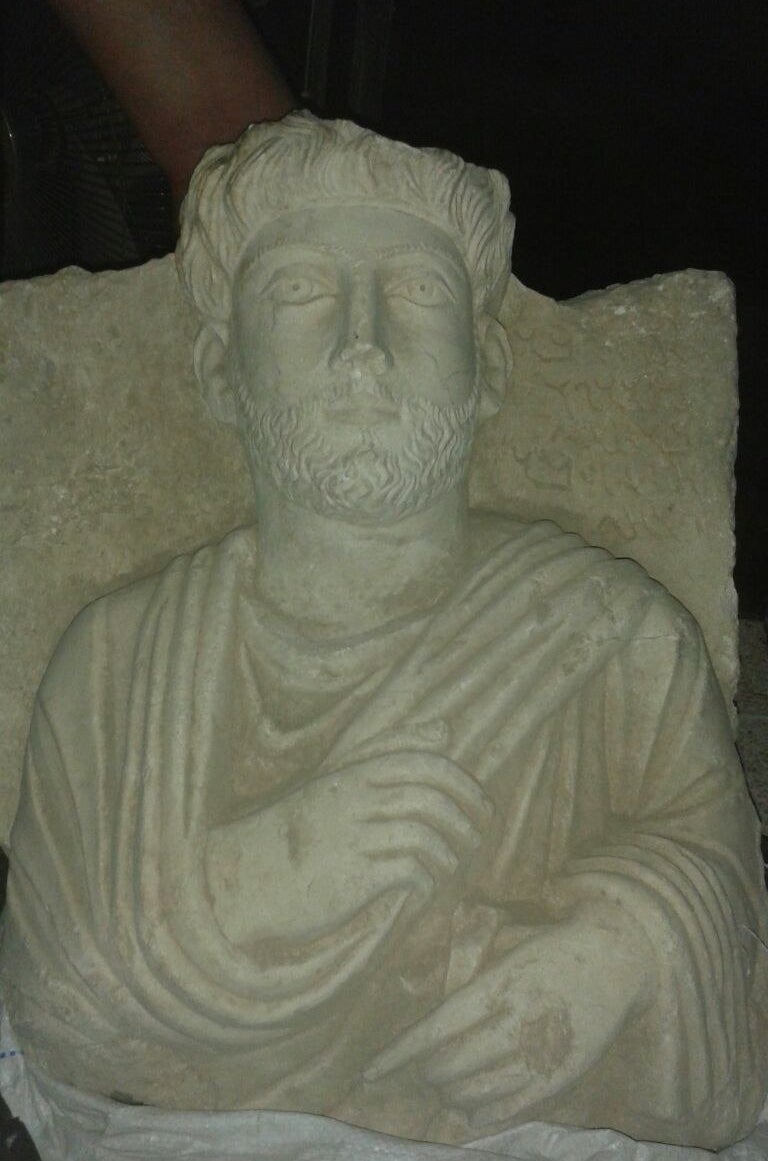
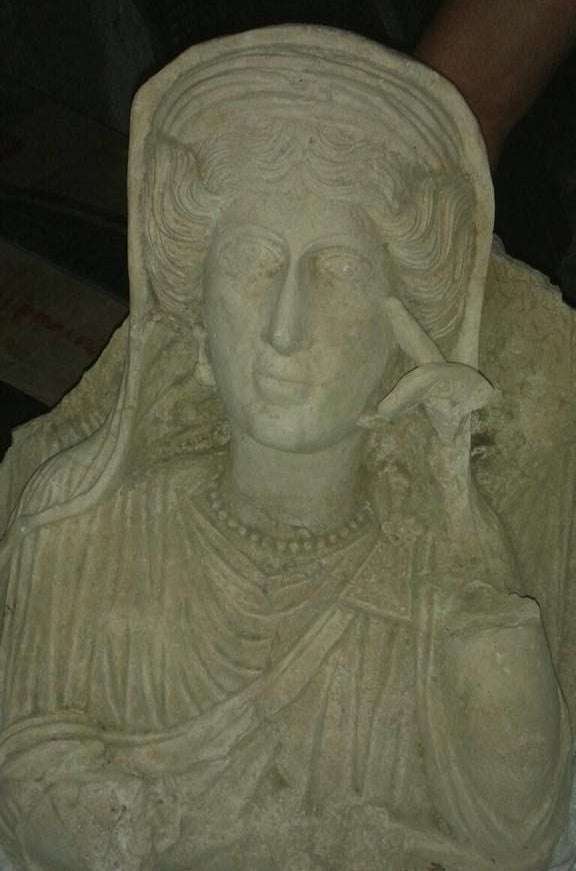
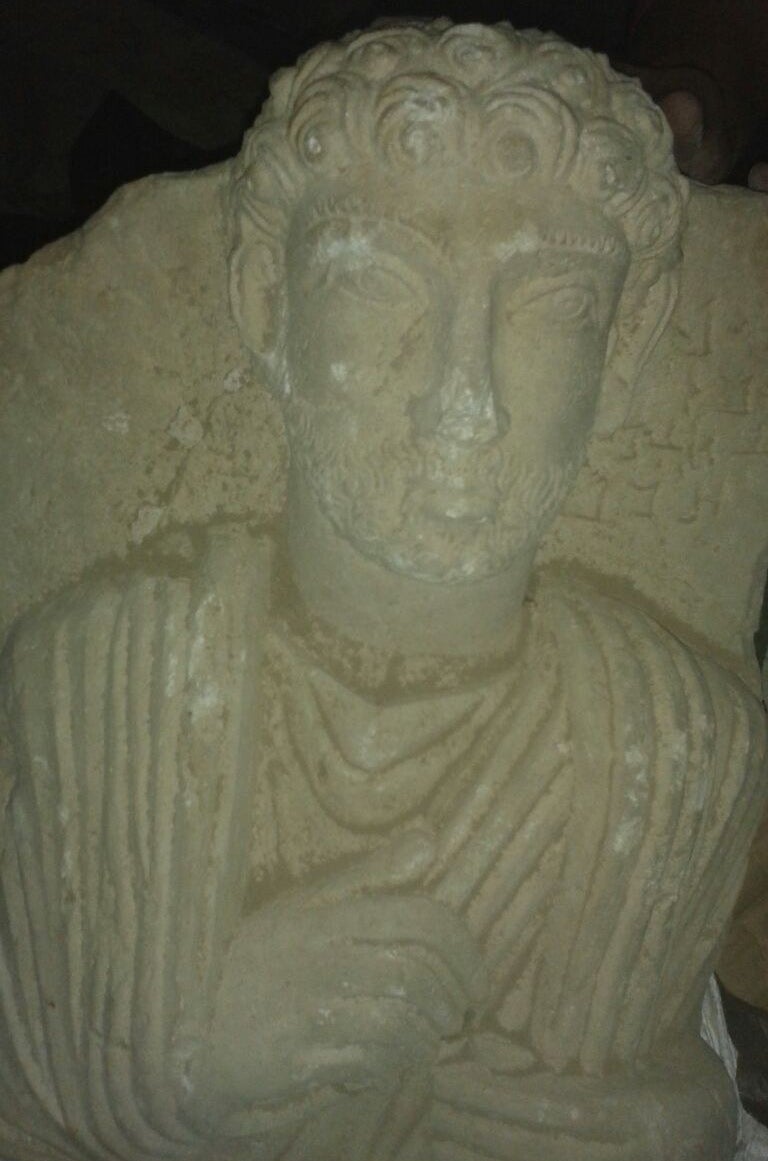
A looter from the ancient city of Palmyra said he uncovered these funerary busts and dozens of other artifacts when robbing a tomb amid the area's vast ruins.
When ISIS stormed the central Syrian city of Palmyra in May, the world recoiled in horror, fearing the destruction of the prized Unesco heritage site.
One week later, I sat in a sunlit living room near the border with a looter from Palmyra who had spent much of the last 15 years robbing grave sites there.
He sat cross-legged on the floor, holding in his lap an ancient funerary bust from the city — a middle-aged woman chiseled into a white slab of rock. He’d been keeping it hidden beneath a bed in the next room, where it helped to hold up a shaky mattress frame. He pointed to details he had used to piece together the woman’s life: She was unmarried because she wore no rings, an artist because she held a paintbrush. She had wide and distinctly Palmyrene eyes. “She’s a real person, and this was made to tell her story,” he said. “Maybe it makes us miss Syria when we look at her.”
A major trading post in antiquity, Palmyra is one of the most important archaeological sites in the Middle East, with 2,000-year-old colonnades and miles of unexcavated ruins, many of them graves and tombs. The looter spent much of his life searching for treasure amid the dirt and bones. “It’s like a well of artifacts,” he said of Palmyra. “It will never finish.”
He found the bust in the fall of 2011, he said, when rebels controlled part of Palmyra’s ruins. He and a team of family and friends had walked into a tomb that held the remains of generations of a wealthy Palmyrene family, along with hundreds of well-preserved statues and busts. He made off with dozens of pieces, he said. He wanted $25,000 for the bust he was holding but said he would take much less. "Syrian history is cheap now," he said.
He asked me not to photograph the bust, since it was on the market, but texted me photos of several others he said he had picked up during the same raid. He had already sold those busts to a friend, he said, and then conspired to smuggle them from Turkey back through Syria and on to Lebanon, a common path because Turkish authorities are far more diligent about cracking down on the trade than their counterparts in Lebanon.
The man seemed happy that the stolen busts were out of ISIS’s reach. But that didn’t last long. Two months after our meeting, on July 2, ISIS published propaganda images showing militants bearing sledgehammers. They stood in a village square before an array of ancient busts. Then they smashed them. The busts in the propaganda — titled “Expropriation of a Group of Statues and Destruction of Contraband” — and the busts in the looter’s photos appeared to be identical.
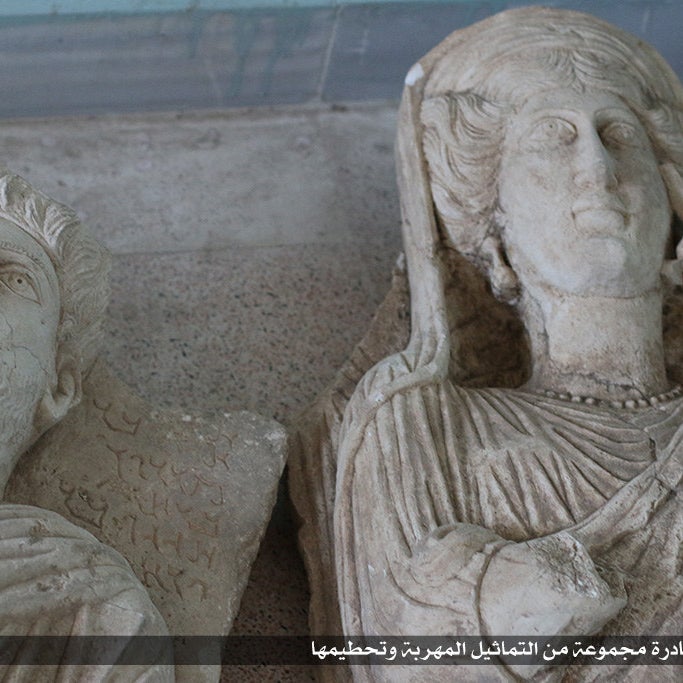
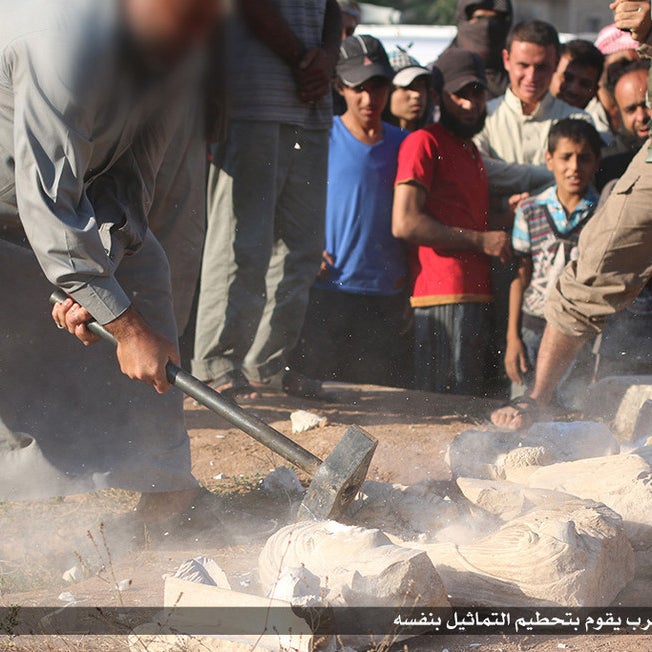
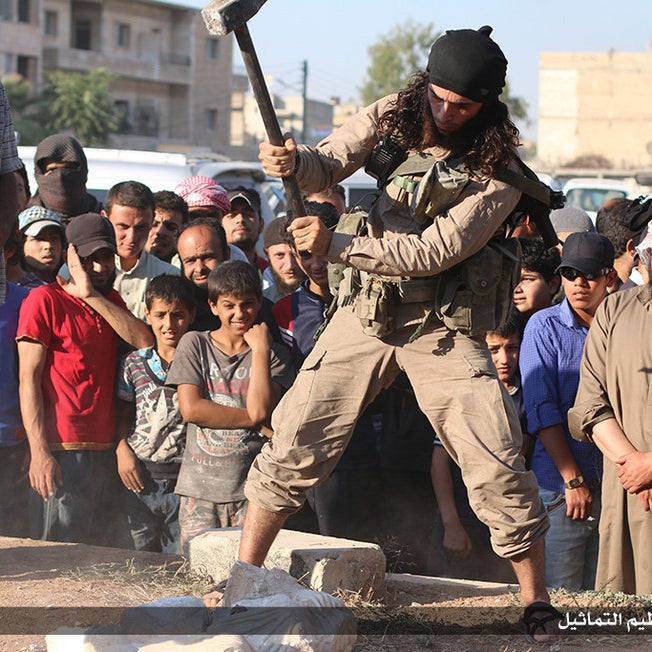
Images from ISIS propaganda showing the destruction of ancient Syrian artifacts.
The looter said he had lost the busts to ISIS because he'd used a smuggler who flouted the strict rules the militant group imposes on the territory it controls. The smuggler had been smoking a cigarette when he pulled into an ISIS checkpoint outside Aleppo, en route to Lebanon. This caused the militants to become suspicious, since they consider smoking a sin, and they decided to search the car, finding the busts inside.
I sent the photos the looter had given me and those from the ISIS images to three archaeologists — Altaweel, Danti, and Amr al-Azm, a professor in Ohio who monitors Syrian antiquities using sources on the ground. All three said they believed that the ISIS militants had smashed the same objects shown in the looter’s photos. “I think you can say with a high degree of certainty that these are the same,” Altaweel said.
Azm added that local ISIS officials would have taxed the busts or sold them, according to his contacts in the area, but the checkpoint seizure drew too much attention locally. "ISIS usually turns a blind eye to the valuable stuff, but the yokels at the checkpoint don’t know that and buy into the propaganda," he said.
Some items have value to ISIS on the market and others for propaganda. With few natural boundaries and a diverse mix of religious and ethnic groups, much of Syria’s national identity is centered on its long and unique history. ISIS is dedicated to destroying that as it works to create its own state based on a fundamentalist vision of an Islamic caliphate.
The looter was furious the busts had been smashed. “Those statues should be in a rich person’s home or in a museum, not under ISIS’s feet,” he said.

After four years of war, Mohamed said, Syria "will never be like it was before." There have been too many lives and too much history lost. "It's a different country now," he said.
Wearing loafers and a button-down shirt, he had come to Istanbul to meet potential buyers, and we sat drinking coffee at a downtown brasserie. His Android phone suddenly erupted as a barrage of photos of artifacts arrived. Scrolling through the new images, he stopped on one that showed an Egyptian coin from the age of Ptolemy, between the first and second centuries A.D., that a contact had uncovered in Syria. It was corroded and nearly worthless, he said, but he seemed happy to have it saved on his phone. "It's history," he said. "And not everyone has the chance to learn the past."
He daydreamed for a minute about finding a way to work legally with antiquities one day, maybe for a museum in Syria if democracy ever came, or even for a legitimate dealer in the West. “Maybe after everything — after everything — I will make this a real job," he said.
He whistled at the idea, shaking his head.
Fifteen hundred miles away, one of London’s top antiquities galleries sits on a pristine street in the heart of Mayfair. Behind the locked wooden door, Martin Clist, the managing director, stepped through the darkened showroom of Charles Ede Ltd., known even among critics of the trade for carrying out its business ethically. It was a quiet afternoon, and Clist, wearing horn-rimmed glasses and a short brown beard, showed me the carefully selected relics, each surrounded by a halo of light. To see them up close, he said, “can make thousands of years disappear in a single glance.”
First he pointed to an Egyptian relief of the pharaoh Akhenaten, and then he held up a drinking bowl made in ancient Athens that showed the god Dionysus. “This is fantastic,” he said. He seemed to find the objects precious less for their price tags (the gallery was asking $100,000 and $343,000 respectively) than for the stories they told. “They are doorways into what we are today,” he said. “It’s a remarkable privilege to be able to handle objects that a lot of people only see in a museum.”
Clist said he sees himself as part of “a business that goes back hundreds, if not thousands, of years.” He also said he feels compelled to make sure that no illicit items come through his doors: On top of his ethical concerns, he doesn't want the gallery’s reputation to be tarnished. He knows many dealers feel the same, he said — though some still keep the practices of a more freewheeling past. “Obviously there are elements of this market that need cleaning up,” he said. “It’s a legacy of different times.”
One of Clist’s roles at the gallery is to stand guard against people like Mohamed, checking the provenance of the antiquities he purchases and keeping an eye out for any tricks. “We know that world exists,” he said, sitting in the gallery’s elegant library. “This is our world. We want to make sure that these two worlds never come together.”


